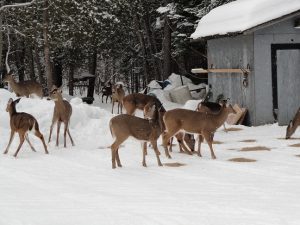
Too Many Does?
By: Randy Spencer
So, deer biologists, can you show us evidence that the population of does is not overbalancing the population of males?
On the upside, I got to hunt almost every day of the season. That means I was out in all sorts of conditions, rain, sleet, snow, and blistering wind. Yes, even on those unseasonable 50-degree days.
It’s what I love. The watching, listening, and being still for hours on end in an attempt to outwit an animal whose eyesight is better than mine, whose hearing is better than mine, and whose life depends on every sensory, instinctual power it can muster.
Along about the second week, I began to realize I didn’t see the deer I would usually have seen by this time. Had they abandoned their old, tried, and true haunts? Did the abundant mast crop have something to do with changing their movements and visibility? Was the high water table and flooding in the woods playing a part as well?
Meanwhile, predictions at the department level are for a near-record breaking harvest. Conversations with other hunters, with only a few exceptions, were corroborating this finding. They didn’t see the deer they were used to seeing. The ones hunting expanded archery lands saw the usual stampede of does, but rarely a buck, even at the peak of the rut.
All of it, of course, is unscientific and would better be described as chatter or grousing. It will most likely be disproven when the harvest numbers eventually come out. There’s one thing, however, that keeps coming up in that chatter, and that’s the buck only law.
Yes, there are many ways around it if you live in or near the right wildlife management districts. You can win the antlerless deer lottery, get a bonus tag, or hunt expanded archery to get an unlimited number of does. However, the state’s buck only regulation is still in effect, making it the rule of law for most of Maine.
Maybe it’s time for the science behind the law to be explained and defended one more time. Too often, in guiding, hosting hunters, and being part of various hunting adventures, the news that comes back to camp is all about does. We know bucks are a retiring animal by nature, except perhaps, during the rut.
It does seem, though, that the hunting routine has become one of several hunters chasing the same buck around a vast area while seeing does on most of these outings. This year, on expanded archery lands, I witnessed 40 does at a time moving as a herd—all without a single buck in the group.
If there were sufficient bucks to warrant hunting efforts being targeted towards them, wouldn’t the most stalwart hunters in the group stumble across bucks more often? So, deer biologists, can you show us at least the evidence that the population does not overbalance the population of males?
I guess you could say that the downside of the season was getting skunked, but that’s only if you discount the love of the hunt. The late-season was excellent, with tracking snow galore. There was tracking snow in early November and some great days to be waving in the wind from a tree stand.
On one memorable evening, I was frozen to my seat, staring straight ahead, when I began to hear rustling off to my left. I studied the cadence and weight of the footfall and determined it seemed right. I started my rotisserie turn to get situated for a shot.
Only, I found it was a quadruped alright, just not the kind I was hoping for. That porcupine was fun to watch, though. He shuffled out of sight about half an hour later.
Getting out there is what it’s all about, which is what I always fall back on when I don’t get a deer. What would I replace that with if it were taken away? Shopping, watching TV, or social media? I don’t think so.
I’m profoundly grateful to be able to go out there each time, full of anticipation that this might be the day. If it isn’t, then tomorrow might be. That’s my connection to the outdoors that I never want to lose. It puts me in tune with the seasons, nature, and maybe even myself.
Randy Spencer is an author and guide. Reach him at [email protected] or via www.randyspencer.com.

